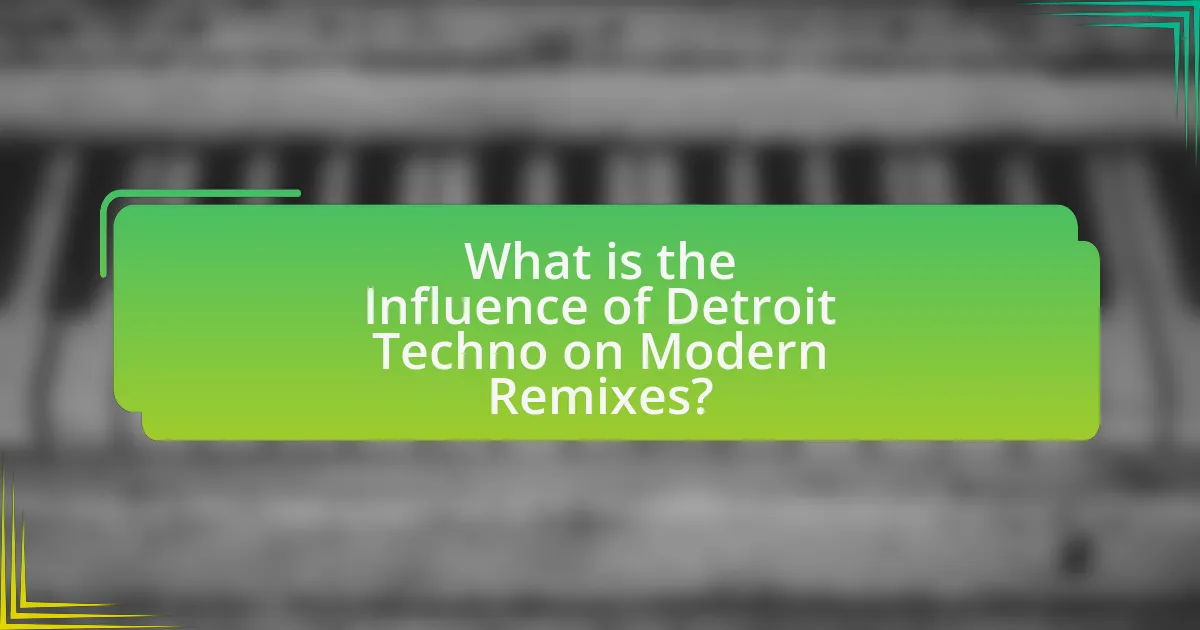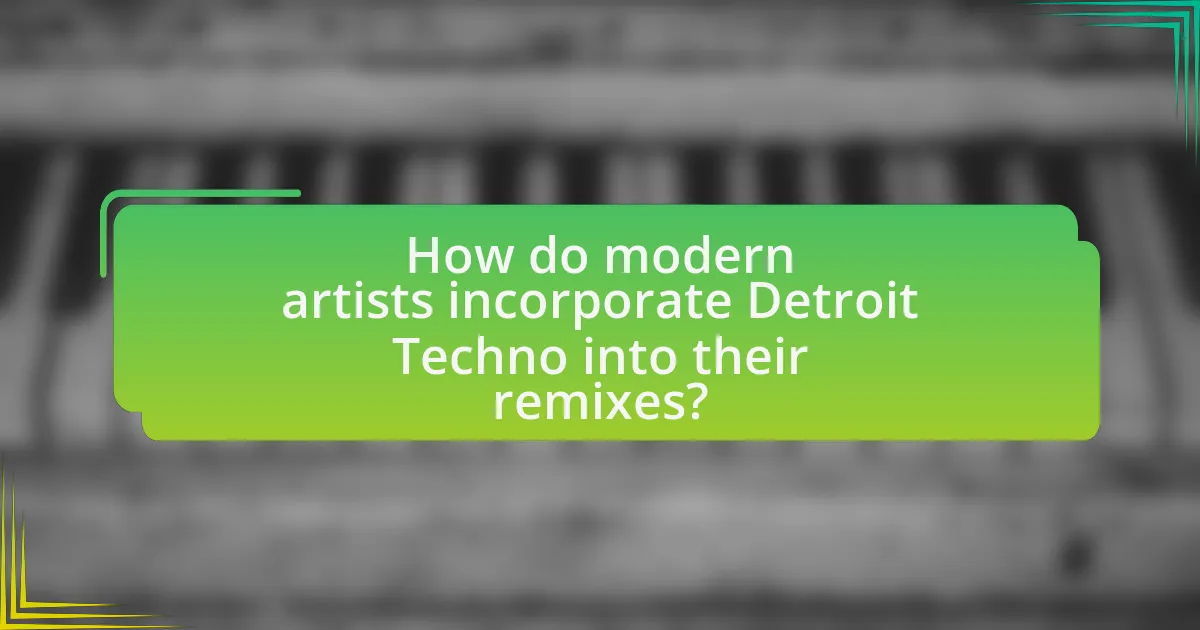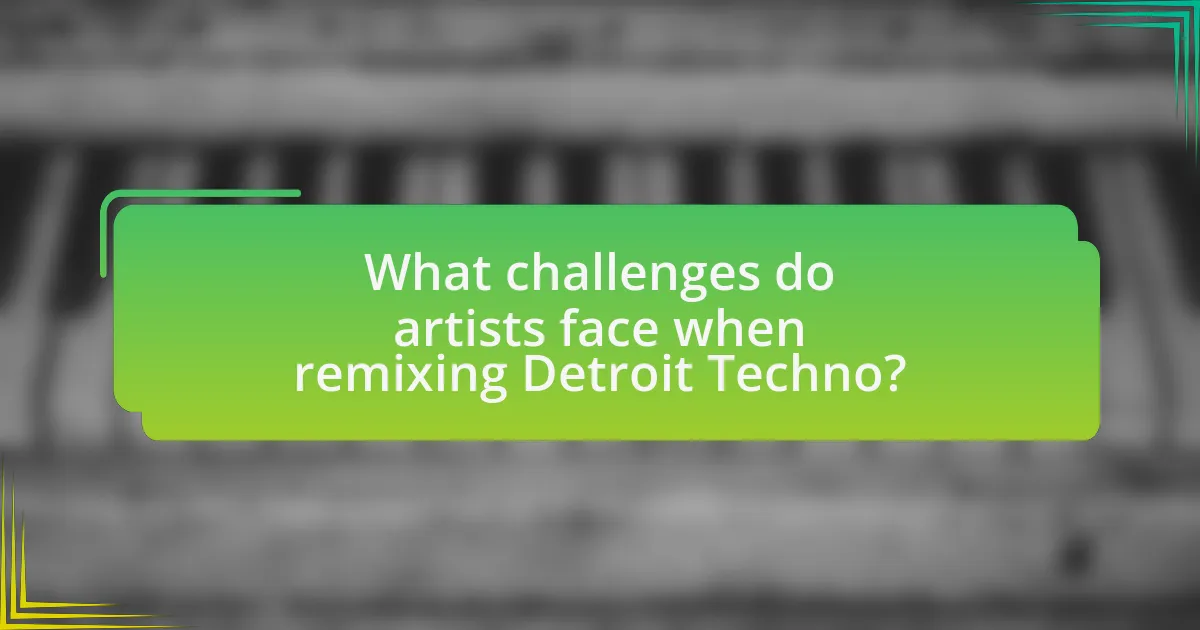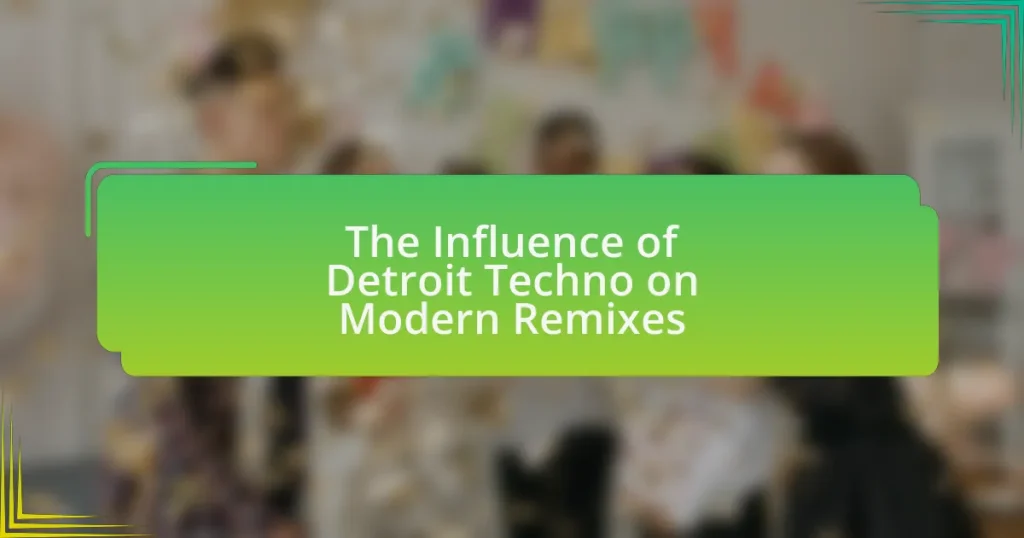The article examines the significant influence of Detroit Techno on modern remixes, highlighting its foundational elements such as repetitive beats, synthesized melodies, and a focus on rhythm. Originating in the 1980s, Detroit Techno was pioneered by artists like Juan Atkins and Derrick May, whose innovative production techniques have shaped contemporary electronic music. The article explores the genre’s evolution, key characteristics, and its impact on various music styles, including house and hip-hop. Additionally, it addresses the challenges artists face when remixing Detroit Techno tracks, including copyright issues and the importance of maintaining authenticity while innovating. Overall, the article underscores the lasting legacy of Detroit Techno in shaping the sound and structure of modern remixes.

What is the Influence of Detroit Techno on Modern Remixes?
Detroit Techno significantly influences modern remixes by introducing foundational elements such as repetitive beats, synthesized melodies, and a focus on rhythm over melody. This genre, originating in the 1980s, laid the groundwork for electronic dance music, which is prevalent in contemporary remix culture. The use of drum machines and sequencers, pioneered by Detroit Techno artists like Juan Atkins and Derrick May, has become a staple in modern production techniques. Additionally, the genre’s emphasis on innovation and experimentation encourages remix artists to explore new sounds and structures, leading to diverse interpretations of original tracks. The impact is evident in the works of current artists who incorporate Detroit Techno’s aesthetic, demonstrating its lasting legacy in shaping the sound of modern remixes.
How did Detroit Techno originate and evolve?
Detroit Techno originated in the 1980s as a fusion of electronic music, funk, and soul, primarily developed by artists like Juan Atkins, Derrick May, and Kevin Saunderson. These pioneers, often referred to as the “Belleville Three,” were influenced by the technological advancements in music production and the socio-economic landscape of Detroit, which included the decline of the auto industry and a vibrant underground music scene.
The genre evolved through the incorporation of various styles, including house music and electro, leading to a distinct sound characterized by repetitive beats, synthesized melodies, and futuristic themes. By the late 1980s and early 1990s, Detroit Techno gained international recognition, influencing a wide range of electronic music genres and artists globally. Its impact is evident in modern remixes, where the rhythmic and melodic elements of Detroit Techno continue to inspire contemporary producers and DJs.
What are the key characteristics of Detroit Techno?
Detroit Techno is characterized by its use of repetitive beats, synthesized melodies, and a fusion of electronic and funk elements. This genre emerged in the 1980s, primarily influenced by the technological advancements in music production and the cultural backdrop of Detroit. Key characteristics include a strong emphasis on rhythm, often featuring a four-on-the-floor beat, and the incorporation of futuristic sounds created through synthesizers and drum machines. Additionally, Detroit Techno often reflects themes of urban life and social commentary, which can be traced back to its origins in the city’s industrial landscape. The genre has significantly influenced modern remixes by introducing these rhythmic and melodic structures, which continue to be foundational in contemporary electronic music.
Who were the pioneers of Detroit Techno and what impact did they have?
The pioneers of Detroit Techno include Juan Atkins, Derrick May, and Kevin Saunderson, who are often referred to as the “Belleville Three.” Their impact on music was profound, as they laid the foundation for electronic dance music by blending elements of funk, soul, and futuristic sounds. Juan Atkins, known for tracks like “Clear,” introduced the concept of techno as a genre, while Derrick May’s “Strings of Life” became a seminal track that defined the sound of Detroit Techno. Kevin Saunderson further popularized the genre with his work in the late 1980s, helping to establish Detroit as a global hub for electronic music. Their innovations in production techniques and use of synthesizers influenced countless artists and genres, shaping the landscape of modern remixes and electronic music worldwide.
Why is Detroit Techno significant in the context of modern music?
Detroit Techno is significant in the context of modern music because it laid the foundational framework for electronic dance music genres that dominate today’s music scene. Originating in the 1980s, Detroit Techno introduced innovative production techniques and a unique blend of influences, including funk, soul, and futuristic themes, which have been widely adopted and evolved in contemporary music. The genre’s pioneers, such as Juan Atkins, Derrick May, and Kevin Saunderson, created a sound that emphasized rhythm and technology, influencing countless artists and subgenres, including house, trance, and dubstep. This impact is evidenced by the global proliferation of techno festivals and the integration of its elements in mainstream pop and hip-hop tracks, showcasing its enduring relevance and transformative power in shaping modern music.
How has Detroit Techno influenced various music genres?
Detroit Techno has significantly influenced various music genres, particularly house, electro, and hip-hop. The genre’s emphasis on repetitive beats and synthesized sounds laid the groundwork for house music, which emerged in Chicago shortly after Detroit Techno’s inception in the 1980s. Additionally, the use of electronic instrumentation and production techniques in Detroit Techno has been adopted by electro artists, who incorporate similar elements into their tracks. Furthermore, hip-hop producers have sampled Detroit Techno tracks, integrating its rhythmic patterns and soundscapes into their music, thereby expanding the genre’s reach and impact. This cross-pollination illustrates how Detroit Techno has shaped the evolution of modern music, influencing both the structure and aesthetic of contemporary genres.
What role does Detroit Techno play in the global music scene?
Detroit Techno serves as a foundational genre in the global music scene, significantly influencing electronic music and various subgenres worldwide. Originating in the 1980s, Detroit Techno introduced innovative production techniques and a distinct sound characterized by repetitive beats and synthesized melodies, which have been adopted and adapted by artists across the globe. The genre’s impact is evident in the rise of house music, trance, and other electronic styles, with notable artists like Derrick May and Juan Atkins pioneering its development. Furthermore, Detroit Techno has inspired countless modern remixes, showcasing its enduring relevance and ability to shape contemporary music trends.
What are the main elements of Detroit Techno that shape modern remixes?
The main elements of Detroit Techno that shape modern remixes include the use of synthesizers, repetitive beats, and a focus on futuristic themes. Synthesizers, such as the Roland TR-808 and TB-303, create distinctive sounds that are foundational in both Detroit Techno and contemporary remixes. Repetitive beats, often characterized by a four-on-the-floor rhythm, provide a driving force that influences the structure of modern tracks. Additionally, the futuristic themes and emotive melodies found in Detroit Techno inspire artists to explore innovative soundscapes in their remixes, reflecting the genre’s legacy. These elements have been pivotal in establishing a sound that continues to resonate in today’s electronic music landscape.
How do rhythm and beats from Detroit Techno influence remixing techniques?
Rhythm and beats from Detroit Techno significantly influence remixing techniques by establishing a foundation of syncopation and minimalism that remixers often adopt. The characteristic four-on-the-floor beat, combined with intricate hi-hat patterns and deep basslines, creates a driving energy that remixers utilize to enhance the danceability of tracks. This influence is evident in the way remixers manipulate these rhythmic elements, layering additional sounds or altering tempos to create unique interpretations while maintaining the essence of the original track. The historical context of Detroit Techno, emerging in the 1980s, showcases its role in shaping electronic music, with artists like Derrick May and Juan Atkins pioneering techniques that prioritize rhythm and groove, which are now staples in modern remixing practices.
What sound design elements from Detroit Techno are prevalent in modern remixes?
Modern remixes prominently feature sound design elements from Detroit Techno, including the use of synthesized basslines, minimalistic drum patterns, and atmospheric pads. Synthesized basslines, characterized by their deep and resonant qualities, create a driving force in tracks, reminiscent of the work of pioneers like Derrick May and Juan Atkins. Minimalistic drum patterns, often utilizing 808 and 909 drum machines, provide a rhythmic foundation that emphasizes groove and repetition, a hallmark of Detroit Techno. Additionally, atmospheric pads contribute to the overall texture of modern remixes, adding depth and a sense of space, which aligns with the emotive qualities found in classic Detroit tracks. These elements collectively showcase the enduring influence of Detroit Techno on contemporary electronic music.

How do modern artists incorporate Detroit Techno into their remixes?
Modern artists incorporate Detroit Techno into their remixes by utilizing its signature elements such as driving basslines, syncopated rhythms, and futuristic synth sounds. These artists often sample classic Detroit Techno tracks or reinterpret its motifs, blending them with contemporary genres like house, hip-hop, and electronic music. For instance, artists like Derrick May and Carl Craig have influenced newer producers who adopt the genre’s characteristic 4/4 beats and melodic structures, ensuring the essence of Detroit Techno remains present in modern remixes. This integration not only pays homage to the genre’s roots but also revitalizes its sound for new audiences, demonstrating its lasting impact on the electronic music landscape.
What techniques do artists use to blend Detroit Techno with contemporary styles?
Artists blend Detroit Techno with contemporary styles primarily through the use of sampling, layering, and incorporating modern production techniques. Sampling allows artists to integrate iconic sounds and rhythms from classic Detroit Techno tracks into new compositions, creating a bridge between the past and present. Layering involves combining various electronic elements, such as synths and drum patterns, to create a rich, textured sound that reflects both genres. Additionally, contemporary production techniques, such as digital audio workstations and effects processing, enable artists to manipulate and enhance these sounds, resulting in innovative remixes that honor the roots of Detroit Techno while appealing to modern audiences. This approach is evident in the works of artists like Derrick May and Carl Craig, who have successfully merged traditional elements with contemporary influences, showcasing the genre’s evolution.
How do sampling and layering play a role in this integration?
Sampling and layering are crucial techniques in the integration of Detroit techno into modern remixes, as they allow for the incorporation of diverse sounds and textures that define the genre. Sampling enables artists to extract and reuse elements from classic Detroit techno tracks, creating a bridge between past and present musical styles. Layering, on the other hand, involves stacking multiple sound elements to create a rich, complex auditory experience, which is a hallmark of both Detroit techno and contemporary remix culture. This combination not only preserves the essence of the original tracks but also enhances them, resulting in innovative remixes that resonate with both nostalgic and new audiences.
What are some notable examples of successful remixes influenced by Detroit Techno?
Notable examples of successful remixes influenced by Detroit Techno include “The Bells” by Jeff Mills, remixed by various artists, and “Strings of Life” by Derrick May, which has seen numerous reinterpretations. These tracks exemplify the genre’s signature elements, such as driving rhythms and innovative sound design, which have been adopted in remixes across electronic music. For instance, “Strings of Life” has been remixed by artists like Carl Craig, showcasing the lasting impact of Detroit Techno on contemporary electronic music.
Why do listeners resonate with Detroit Techno-influenced remixes?
Listeners resonate with Detroit Techno-influenced remixes due to the genre’s unique blend of rhythmic complexity and emotional depth. Detroit Techno, originating in the 1980s, incorporates elements such as repetitive beats, synthesized melodies, and a futuristic sound that evokes a sense of nostalgia and innovation. This combination creates an immersive experience that appeals to listeners’ desire for both danceability and introspection. The genre’s roots in African American culture and its connection to social movements further enhance its emotional resonance, making it relatable to diverse audiences. Additionally, the influence of iconic Detroit artists like Derrick May and Juan Atkins has established a lasting legacy that continues to inspire contemporary remixers, ensuring that the essence of Detroit Techno remains relevant and impactful in modern music.
What emotional and cultural connections do listeners have with this music?
Listeners have deep emotional and cultural connections with Detroit techno music, often associating it with themes of liberation, community, and resilience. This genre emerged in the 1980s as a response to the socio-economic challenges faced by Detroit, reflecting the city’s industrial roots and the struggles of its residents. The music evokes feelings of nostalgia and empowerment, as it represents a cultural movement that transcended racial and social barriers, fostering unity among diverse groups. Additionally, the repetitive beats and synthesized sounds create an immersive experience that resonates with listeners on a personal level, often serving as a soundtrack for significant life events and communal gatherings. The historical context of Detroit techno, rooted in the city’s rich musical heritage, further enhances its cultural significance, making it a vital part of the global electronic music landscape.
How does nostalgia for Detroit Techno affect modern remix popularity?
Nostalgia for Detroit Techno significantly enhances modern remix popularity by creating a cultural connection that resonates with both older and newer audiences. This genre, originating in the 1980s, is characterized by its innovative sound and cultural significance, which has led to a revival in interest as artists and producers seek to evoke the emotional and historical context associated with it. The resurgence of Detroit Techno elements in contemporary remixes can be seen in the works of artists like Derrick May and Carl Craig, whose influence is evident in the production styles of modern electronic music. Additionally, platforms like Bandcamp and SoundCloud showcase numerous remixes that pay homage to Detroit Techno, reflecting its enduring legacy and the desire for authenticity in music. This nostalgia not only drives the creation of remixes but also fosters a community that appreciates the roots of electronic music, thereby increasing the popularity of these modern interpretations.

What challenges do artists face when remixing Detroit Techno?
Artists face several challenges when remixing Detroit Techno, primarily due to its unique sound characteristics and cultural significance. The genre is deeply rooted in specific rhythmic patterns, synthesizer sounds, and production techniques that are essential to its identity. Artists must navigate the complexity of maintaining the original essence while introducing innovative elements, which can be difficult given the genre’s established conventions. Additionally, there is the challenge of respecting the cultural heritage of Detroit Techno, which originated in the 1980s and is associated with the city’s socio-economic context. This requires artists to be sensitive to the genre’s history and its pioneers, ensuring that their remixes honor the original works while still appealing to contemporary audiences.
How do copyright issues impact the remixing of Detroit Techno tracks?
Copyright issues significantly impact the remixing of Detroit Techno tracks by restricting the use of original samples and compositions without proper licensing. The original creators of Detroit Techno, such as Derrick May and Juan Atkins, retain rights to their works, which means that remixers must obtain permission or pay royalties to legally use these tracks. Failure to do so can result in legal action, including takedown notices or lawsuits, as seen in various cases within the music industry where unauthorized remixes have been challenged. This legal framework creates barriers for artists who wish to innovate and build upon existing works, ultimately influencing the creative landscape of Detroit Techno remixes.
What are the common legal pitfalls artists should be aware of?
Common legal pitfalls artists should be aware of include copyright infringement, contract disputes, and issues related to licensing. Copyright infringement occurs when artists use someone else’s work without permission, which can lead to legal action and financial penalties. Contract disputes often arise from unclear agreements regarding rights, royalties, and responsibilities, potentially resulting in costly litigation. Additionally, licensing issues can emerge when artists fail to secure the necessary rights to sample or remix existing works, which is particularly relevant in the context of Detroit Techno’s influence on modern remixes. Understanding these legal aspects is crucial for artists to protect their work and avoid potential legal challenges.
How can artists navigate these challenges effectively?
Artists can navigate the challenges of modern remixes influenced by Detroit techno by embracing collaboration and leveraging technology. Collaboration allows artists to combine diverse skills and perspectives, enhancing creativity and innovation in their work. For instance, many successful remixes today involve partnerships between producers, vocalists, and instrumentalists, which can lead to unique soundscapes that resonate with audiences. Additionally, utilizing technology such as digital audio workstations (DAWs) and online platforms for distribution enables artists to produce high-quality music and reach wider audiences efficiently. According to a 2021 study by the International Journal of Music Business Research, artists who actively engage in collaborative projects and utilize digital tools report higher levels of success and audience engagement.
What best practices should artists follow when creating Detroit Techno remixes?
Artists should prioritize authenticity and respect for the original tracks when creating Detroit Techno remixes. This involves understanding the genre’s roots, which are deeply embedded in the cultural and musical landscape of Detroit, characterized by its use of synthesizers, drum machines, and a blend of funk, soul, and electronic elements.
Incorporating elements such as the signature 4/4 beat, syncopated basslines, and atmospheric pads can enhance the remix’s connection to the original. Additionally, artists should consider the emotional and thematic content of the original track, ensuring that their remix captures the essence of the Detroit Techno sound while adding their unique interpretation.
Moreover, collaborating with original artists or producers can provide valuable insights and maintain the integrity of the remix. Engaging with the Detroit Techno community through events or online platforms can also foster a deeper understanding of the genre’s evolution and current trends, which is crucial for creating relevant and impactful remixes.
How can artists maintain authenticity while innovating in their remixes?
Artists can maintain authenticity while innovating in their remixes by integrating their unique musical identity and influences into the remix process. This approach allows artists to honor the original work while adding their personal touch, which is essential in genres like Detroit Techno that emphasize individuality and creativity. For instance, many successful remixes in the Detroit Techno scene incorporate signature sounds or techniques that reflect the artist’s background, such as specific synthesizer choices or rhythmic patterns. This practice not only preserves the essence of the original track but also showcases the artist’s evolution and innovation, reinforcing their authenticity in the music landscape.
What resources are available for artists looking to learn more about Detroit Techno?
Artists looking to learn more about Detroit Techno can access a variety of resources, including books, documentaries, online courses, and music archives. Notable books such as “Energy Flash: A Journey Through Rave Music and Dance Culture” by Simon Reynolds provide historical context and analysis of the genre. Documentaries like “High Tech Soul: The Creation of Techno Music” offer visual insights into the origins and evolution of Detroit Techno. Online platforms such as MasterClass and Coursera feature courses on electronic music production that often include sections on Detroit Techno. Additionally, the Detroit Sound Conservancy and the Detroit Historical Society maintain archives and host events that celebrate and educate about the genre, providing artists with direct access to primary sources and community knowledge.


